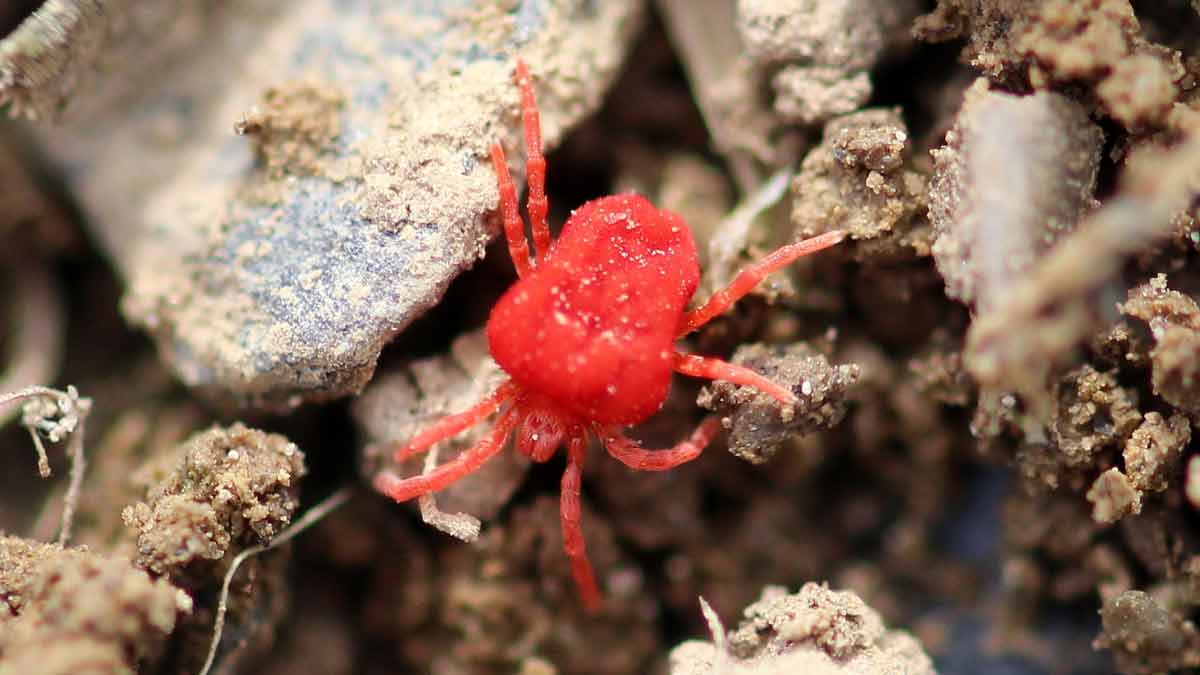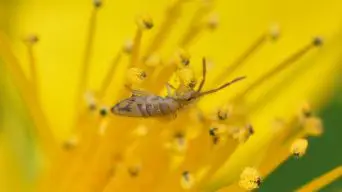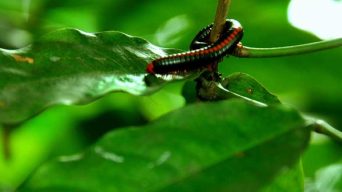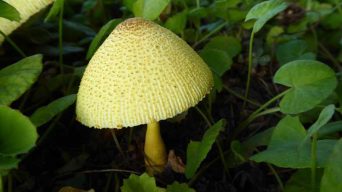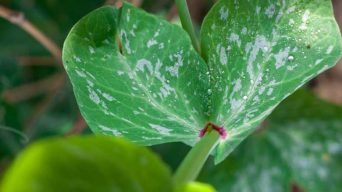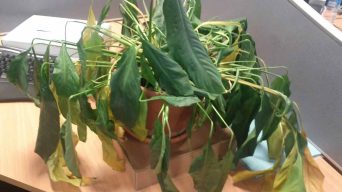Removing decaying matter from indoor plants can help get rid of soil mite infestations. Other solutions include replacing potting soil, using neem oil, and using diatomaceous earth. However, soil mites are generally harmless and beneficial to the soil.
Indoor plants bring life and beauty to our homes but can also attract unwanted guests – soil mites.
These tiny creatures may not directly harm your beloved potted plants, but their presence can be unsightly and unsettling.
In this easy guide, we’ll show you how to get rid of soil mites in indoor plants so you can enjoy a pest-free environment.
Keep reading to learn the steps for banishing these pesky critters once and for all!
Understanding Soil Mites And Their Effects On Indoor Plants
Soil mites are tiny arthropods that live in potting soil and feed on decaying matter. Still, their presence can have detrimental effects on indoor plants.
Common signs of soil mite infestations include stunted growth, yellowing leaves, and decreased plant health overall.
Common Causes Of Soil Mite Infestations
One of the primary causes of soil mite infestations in indoor plants is the use of low-quality potting soil.
This soil type often contains organic matter, which attracts and provides a perfect environment for these tiny bugs to thrive.
When repotting or adding new houseplants to your collection, choosing high-quality soil that is free from contaminants and rich in nutrients is crucial.
Overwatering your plants can also create favorable conditions for soil mites to multiply rapidly.
Excess moisture promotes mold growth and allows mites to navigate easily through the damp environment.
Mites are particularly drawn to decaying leaves, stems, and other organic materials on moist surfaces.
To prevent this kind of infestation, use proper watering techniques for each plant type – an approach known as ‘right-sizing’ irrigation strategy.
Lastly, overcrowding your potted plants can increase the likelihood of a soil mite infestation by creating shared habitats among multiple plant pots where populations transfer quickly between their hosts.
Maintaining ample space between indoor plants will help ensure healthy airflow and minimize chances for critters like these houseplant pests to make themselves home across your entire garden ecosystem.
Signs Of Soil Mites In Indoor Plants
Soil mites are tiny arachnids that can lurk in your indoor plants’ soil.
Since they are not visible to the naked eye, spotting them at first glance may be difficult.
One sign of soil mite infestation is the appearance of webs or threads on top of the plant soil.
Moreover, if you notice tiny insects crawling around in and on top of your plant’s potting mix or see small bite marks on leaves, these could be evidence of soil mites’ presence.
Another potential indicator is a plant’s failure to thrive under normal conditions as it struggles with nutrient uptake due to decaying matter left by infesting pests.
Other symptoms include yellowing leaves, wilting foliage, and stunted growth even after years planted in one location within an indoor garden.
If any such signs arise, then it might be best to take quick action before the soil mite population gets out of hand:
- Cleaning up excess debris from pots/containers.
- Replacing old potting mixes prone to harboring pest populations.
- Using natural remedies like diatomaceous earth powder mixed into water sprays applied directly onto leaf undersides (where eggs tend to stick) – avoid overuse which will dry out plants!
Steps To Get Rid Of Soil Mites In Indoor Plants
To get rid of houseplant soil mites, start by identifying the type of mites present and remove the top layer of soil, then use natural remedies such as diatomaceous earth or neem oil or pesticides if necessary.
Learn more about effectively managing these pesky pests in your indoor plants!
Identify The Type Of Soil Mites Present
Before you start treating soil mites in indoor plants, it is crucial to identify the type of mites present.
The most common types are spider mites and springtails.
Spider mites are tiny pests that spin webs on the leaves and stems of your plants.
On the other hand, springtails are tiny insects that feed on decaying matter in the soil.
To identify which type of soil mite is infesting your plant, scoop up a sample of soil from around its roots and place it on a white or black piece of paper.
Break apart any clumps and inspect closely with a magnifying glass if possible.
If you see tiny spider-like creatures moving around, they are spider mites.
However, if you see small insects bouncing or jumping out of the soil under bright light conditions, they are likely to be springtails.
Once you have identified the type of soil mite in your indoor plants correctly, you can move on to removing them before causing more damage to your beloved houseplants!
Remove The Top Layer Of Soil
Removing the top layer of soil is an effective way to get rid of soil mites in your indoor plants.
Here are the steps to follow:
- Gently remove the plant from its pot and place it on a clean surface.
- Use a small garden trowel or your hands to scoop out the top inch or two of soil.
- Discard the removed soil in a sealed bag or container to prevent any remaining mites from spreading to other plants.
- Replace with fresh, high-quality potting soil, being careful not to compact it too tightly around the roots.
By removing the top layer of infested soil, you can remove many existing mites and their eggs, which can help prevent future infestations.
It’s important to also use natural remedies or pesticides in conjunction with this step for best results.
Use Natural Remedies Such As Diatomaceous Earth, Neem Oil, Or Cinnamon
Natural remedies can be an effective way to get rid of soil mites in your indoor plants.
One such remedy is diatomaceous earth, a powdery substance made from fossilized remains of tiny aquatic organisms called diatoms.
To use it, sprinkle the powder on top of the soil and mix it in. This method works by dehydrating the mites and their eggs, ultimately killing them off.
Another natural solution is neem oil, an essential oil extracted from the seeds of the neem tree.
Mix a few drops into water and spray them onto the soil and plant leaves to deter mites from returning.
Similarly, cinnamon can also be used as a natural repellent for soil mites. Sprinkle ground cinnamon on top of the soil or mix some into the water and spray it onto your plants’ leaves.
Using natural remedies like diatomaceous earth, neem oil, or cinnamon instead of harsh chemicals that may harm your houseplants’ health effectively eliminates pesky soil mites while keeping your indoor garden healthy and safe for you and your family.
Apply Pesticides (if Necessary)
If natural remedies fail to eliminate soil mites from your indoor plants, it may be necessary to use chemical pesticides to get rid of them.
Follow these steps:
- Choose a pesticide labeled for use on houseplants that specifically targets soil mites.
- Follow the instructions on the label carefully to ensure safe and effective use.
- Apply the pesticide evenly over the top layer of soil using a spray bottle or watering can.
- Avoid overuse of pesticides, as this can harm your plant’s health and encourage resistance to pests.
- Monitor your plant closely after applying pesticides for any signs of stress or damage.
Remember that chemical pesticides should only be used as a last resort.
Always follow the manufacturer’s instructions carefully to avoid adverse effects on your plants or personal health.
Maintain Proper Plant Hygiene
Maintaining proper plant hygiene is crucial to keeping soil mites at bay.
Regularly inspecting your plants for any signs of infestation and removing the affected areas, leaves, or stems can prevent the spread of soil mites.
It’s important to clean up any fallen leaves or debris around your houseplants, as they can create a perfect breeding ground for soil pests like mites.
In addition, it is essential to keep the top layer of soil fresh and remove any dead or decaying matter from the surface.
This will help deprive soil mites of their food source and discourage them from inhabiting your indoor plants.
Using high-quality potting soil that supports healthy root growth also helps promote overall plant health and reduces the risk of pest infestations.
Regular watering using appropriate techniques such as bottom watering not only helps avoid waterlogging but also enables good drainage, contributing significantly to maintaining healthy plant hygiene.
By following these basic practices, you can ensure that your indoor plants stay vibrant, lush, and free from pesky soil mites all year round while providing optimal conditions for plant growth.
Preventive Measures To Avoid Soil Mite Infestation
To prevent soil mite infestations, it’s essential to use high-quality soil, avoid overcrowding of plants, maintain proper plant hygiene, and regularly inspect plants for signs of infestation.
Keep reading to learn more about how to keep your indoor plants healthy and free from soil mites!
Use High-quality Soil
High-quality soil is crucial in preventing soil mite infestations in indoor plants.
Low-quality soil can contain pests, pathogens, and other harmful substances that attract these bugs.
Choosing a potting mix that is well-draining and made of quality ingredients such as peat moss, vermiculite, perlite, or coconut coir is essential.
Moreover, avoid using garden soil or reused soil from past indoor plants as it may contain unwanted pests or diseases.
Investing in a good-quality potting mix will be worth the price as it ensures healthy plant growth and minimizes the need for frequent repotting.
Always read the label before purchasing any potting soil to ensure its composition meets your requirements for specific plants.
Doing so guarantees healthier indoor gardening practices while eliminating potential problems like soil mites and other pest infestations down the line.
Proper Watering Techniques
Proper watering techniques are critical to preventing soil mite infestations in indoor plants.
Here’s how you can ensure your plants receive the right amount of water without creating ideal conditions for soil mites to thrive:
- Water only when the top inch of soil is dry to the touch.
- Use pots with drainage holes and avoid letting plants sit in standing water.
- Water deeply, soaking the entire root ball, rather than giving plants a light sprinkle.
- Use room temperature water rather than cold water, which can shock plant roots.
- Avoid overwatering or underwatering, as both can weaken plants and leave them vulnerable to soil mites and other pests.
Following these simple tips, you can keep indoor plants healthy and happy without inviting soil mites into your home.
Avoid Overcrowding Of Plants
It’s easy to get carried away with indoor gardening and end up with too many plants in one area.
However, overcrowding can lead to soil mite infestations.
As plants compete for nutrients in a crowded space, the soil becomes depleted, providing an ideal breeding ground for pests like soil mites.
To avoid overcrowding your indoor plants:
- Consider each plant’s mature size when choosing a pot and placement location.
- Make sure there is enough space between each plant so they can grow properly without competing for resources.
- If you have limited space but still want multiple plants, consider using hanging baskets or shelving units to maximize vertical space.
Additionally, regularly inspecting your houseplants can help prevent overcrowding and catch any signs of pest infestation early on.
By closely monitoring your plant’s health and spacing them out appropriately, you’ll enjoy beautiful greenery without worrying about nasty bugs ruining the fun.
Regularly Inspect Plants For Signs Of Infestation
Regularly inspecting your indoor plants is one of the most effective ways to prevent soil mite infestations from getting out of hand. Here are a few signs to look for:
- Visible mites on the plant or soil surface.
- Tiny white or black specks move around in the soil.
- The presence of webbing is a clear indication of spider mites.
- Drooping, yellowing leaves, and stunted growth.
Inspecting plants regularly can help catch soil mite infestations early on, making them easier to manage and prevent future outbreaks.
Final Thoughts
Keeping indoor plants healthy and soil mite-free is easy with these simple steps.
By understanding the causes and signs of soil mites in indoor plants, you can take action to remove them using natural remedies or chemical pesticides if necessary.
Regularly inspecting your plants and maintaining proper plant hygiene can also help prevent future infestations.
With the proper knowledge and tools, you can keep your houseplants thriving while enjoying a bug-free environment!

